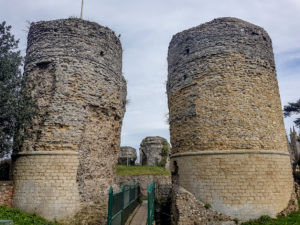Dunnottar Castle is a ruined medieval fortress located upon a rocky headland on the northeastern coast of Scotland, about 2 miles south of Stonehaven. The surviving buildings are large of the 15th and 16th centuries, but the site is believed to have been fortified in the Early Middle Ages. Dunnottar has played a prominent role in the history of Scotland through to the 18th-century Jacobite risings because of its strategic location and defensive strength.
Dunnottar is best known as the place where the Honours of Scotland, the Scottish crown jewels, were hidden from Oliver Cromwell’s invading army in the 17th century. The property of the Keiths from the 14th century, and the seat of the Earl Marischal, Dunnottar declined after the last Earl forfeited his titles by taking part in the Jacobite rebellion of 1715. The castle was restored in the 20th century and is now open to the public.
The ruins of the castle are spread over 1.4 hectares, surrounded by steep cliffs that drop to the North Sea, 160 feet below. A narrow strip of land joins the headland to the mainland, along which a steep path leads up to the gatehouse.
A chapel at Dunnottar is said to have been founded by St Ninian in the 5th century, although it is not clear when the site was first fortified, in any case, the legend is late and highly implausible. Possibly the earliest written reference to the site is found in the Annals of Ulster which record two sieges of “Dún Foither” in 681 and 694. The earlier event has been interpreted as an attack by Brude, the Pictish king of Fortriu, to extend his power over the north-east coast of Scotland. The Scottish Chronicle records that King Donald II of Scotland, the first ruler to be called rí Alban (King of Alba), was killed at Dunnottar during an attack by Vikings in 900. The English king Æthelstan led a force into Scotland in 934 and raided as far north as Dunnottar according to the account of Symeon of Durham.
During the reign of King William the Lion (ruled 1165–1214) Dunnottar was a center of local administration for The Mearns. The castle is named in the Roman de Fergus, an early 13th-century Arthurian romance, in which the hero Fergus must travel to Dunnottar to retrieve a magic shield. In May 1276 a church on the site was consecrated by William Wishart, Bishop of St Andrews.[10] The poet Blind Harry relates that William Wallace captured Dunnottar from the English in 1297, during the Wars of Scottish Independence. He is said to have imprisoned 4,000 defeated English soldiers in the church and burned them alive.
In 1336 Edward III of England ordered William Sinclair, 8th Baron of Roslin, to sail eight ships to the partially ruined Dunnottar for the purpose of rebuilding and fortifying the site as a forward resupply base for his northern campaign. Sinclair took with him 160 soldiers, horses, and a corps of masons and carpenters. Edward himself visited in July, but the English efforts were undone before the end of the year when the Scottish Regent Sir Andrew Murray led a force that captured and again destroyed the defenses of Dunnottar.
In the 14th century, Dunnottar was granted to William de Moravia, 5th Earl of Sutherland (d.1370), and in 1346 a license to crenelate was issued by David II. Around 1359 William Keith, Marischal of Scotland, married Margaret Fraser, niece of Robert the Bruce, and was granted the barony of Dunnottar at this time. Keith then gave the lands of Dunnottar to his daughter Christian and son-in-law William Lindsay of Byres, but in 1392 an excambion (exchange) was agreed whereby Keith regained Dunnottar and Lindsay took lands in Fife. William Keith completed construction of the tower house at Dunnottar but was excommunicated for building on the consecrated ground associated with the parish church. Keith had provided a new parish church closer to Stonehaven but was forced to write to the Pope, Benedict XIII, who issued a bull in 1395 lifting the ex-communication. William Keith’s descendants were made Earls Marischal in the mid 15th century, and they held Dunottar until the 18th century.







